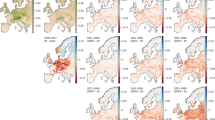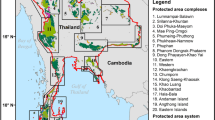Abstract
Climate change is threatening global ecosystems through its impact on the survival of individual species and their ecological functions1,2. Despite the important role of understorey plants in forest ecosystems3,4,5, climate impact assessments on understorey plants and their role in supporting wildlife habitat are scarce in the literature. Here we assess climate-change impacts on understorey bamboo species with an emphasis on their ecological function as a food resource for endangered giant pandas (Ailuropoda melanoleuca). An ensemble of bamboo distribution projections associated with multiple climate-change projections and bamboo dispersal scenarios indicates a substantial reduction in the distributional ranges of three dominant bamboo species in the Qinling Mountains, China during the twenty-first century. As these three species comprise almost the entire diet of the panda population in the region, the projected changes in bamboo distribution suggest a potential shortage of food for this population, unless alternative food sources become available. Although the projections were developed under unavoidable simplifying assumptions and uncertainties, they indicate potential challenges for panda conservation and underscore the importance of incorporating interspecific interactions into climate-change impact assessments and associated conservation planning.
This is a preview of subscription content, access via your institution
Access options
Subscribe to this journal
Receive 12 print issues and online access
$209.00 per year
only $17.42 per issue
Buy this article
- Purchase on Springer Link
- Instant access to full article PDF
Prices may be subject to local taxes which are calculated during checkout




Similar content being viewed by others
Change history
15 November 2012
In the version of this Letter originally published online, in the penultimate sentence of the abstract it should have read 'the projected changes in bamboo distribution suggest a potential shortage of food for this population'. This error has now been corrected in all versions of the Letter.
References
IPCC Climate Change 2007: Impacts, Adaptation and Vulnerability (eds Parry, M. L., Canziani, O. F., Palutikof, J. P., van der Linden, P. J. & Hanson, C. E.) (Cambridge Univ. Press, 2007).
Parmesan, C. Ecological and evolutionary responses to recent climate change. Annu. Rev. Ecol. Evol. Syst. 37, 637–669 (2006).
Gilliam, F. S. The ecological significance of the herbaceous layer in temperate forest ecosystems. Bioscience 57, 845–858 (2007).
Nilsson, M-C. & Wardle, D. A. Understory vegetation as a forest ecosystem driver: Evidence from the northern Swedish boreal forest. Front. Ecol. Environ. 3, 421–428 (2005).
Deal, R. L. Management strategies to increase stand structural diversity and enhance biodiversity in coastal rainforests of Alaska. Biol. Conserv. 137, 520–532 (2007).
Taylor, A. H., Huang, J. Y. & Zhou, S. Q. Canopy tree development and undergrowth bamboo dynamics in old-growth Abies-Betula forests in Southwestern China: A 12-year study. Forest Ecol. Manag. 200, 347–360 (2004).
Griscom, B. W. & Ashton, P. M. S. Bamboo control of forest succession:Guadua sarcocarpa in Southeastern Peru. Forest Ecol. Manag. 175, 445–454 (2003).
Pan, W. et al. The Opportunity for the Giant Panda to Exist (Peking Univ. Press, 2001).
Schaller, G. B., Hu, J., Pan, W. & Zhu, J. The Giant Pandas of Wolong (Univ. Chicago Press, 1985).
Bystriakova, N. & Kapos, V. Bamboo diversity: The need for a Red List review. Biodiversity 6, 12–16 (2006).
Janzen, D. H. Why bamboos wait so long to flower. Annu. Rev. Ecol. Syst. 7, 347–391 (1976).
Taylor, A. H., Reid, D. G., Qin, Z. S. & Hu, J. C. Spatial patterns and environmental associates of bamboo (Bashania fangiana Yi) after mass-flowering in southwestern China. Bull. Torrey Bot. Club 118, 247–254 (1991).
Taylor, A. H. & Qin, Z. Structure and dynamics of bamboos in the Wolong Natural Reserve, China. Am. J. Bot. 80, 375–384 (1993).
Tian, X. Shooting and growth of Bashania fargesii. J. Bamboo Res. 8, 400–407 (1989).
State Forestry Administration The Third National Survey Report on Giant Panda in China (Science Press, 2006).
Reid, D. G., Hu, J., Dong, S., Wang, W. & Huang, Y. Giant panda Ailuropoda melanoleuca behaviour and carrying capacity following a bamboo die-off. Biol. Conserv. 49, 85–104 (1989).
Viña, A. et al. Range-wide analysis of wildlife habitat: Implications for conservation. Biol. Conserv. 143, 1960–1969 (2010).
Hijmans, R. J., Cameron, S. E., Parra, J. L., Jones, P. G. & Jarvis, A. Very high resolution interpolated climate surfaces for global land areas. Int. J. Climatol. 25, 1965–1978 (2005).
Tian, X. Studies of the food base of giant panda in Qinling mountains. Acta Theriol. Sin. 10, 88–96 (1990).
Fu, J-H., Liu, Y-Y., Jin, X-L., Ma, Q-Y. & Zhao, P-P. Research on edible bamboo species preference of captive giant pandas in Qinling. Forest. Res. 21, 1–7 (2008).
Wiens, J. A., Stralberg, D., Jongsomjit, D., Howell, C. A. & Snyder, M. A. Niches, models, and climate change: Assessing the assumptions and uncertainties. Proc. Natl Acad. Sci. USA 106, 19729–19736 (2009).
Tian, X. in Scientific Proceedings of Foping Nature Reserve (ed. Zhao, N.) 408–412 (Northwest A&F Univ. Press, 2006).
Liu, J. et al. Ecological degradation in protected areas: The case of Wolong Nature Reserve for giant pandas. Science 292, 98–101 (2001).
Hellmann, J. J., Prior, K. M. & Pelini, S. L. The influence of species interactions on geographic range change under climate change. Ann. NY Acad. Sci. 1249, 18–28 (2012).
Pearson, R. G. & Dawson, T. P. Predicting the impacts of climate change on the distribution of species: Are bioclimate envelope models useful? Glob. Ecol. Biogeogr. 12, 361–371 (2003).
Chen, I. C., Hill, J. K., Ohlemüller, R., Roy, D. B. & Thomas, C. D. Rapid range shifts of species associated with high levels of climate warming. Science 333, 1024–1026 (2011).
Van der Putten, W. H., Macel, M. & Visser, M. E. Predicting species distribution and abundance responses to climate change: Why it is essential to include biotic interactions across trophic levels. Phil. Trans. R. Soc. B 365, 2025–2034 (2010).
Phillips, S. J., Anderson, R. P. & Schapire, R. E. Maximum entropy modeling of species geographic distributions. Ecol. Model. 190, 231–259 (2006).
Ramirez, J. & Jarvis, A. High Resolution Statistically Downscaled Future Climate Surfaces (The International Centre for Tropical Agriculture, 2008).
Acknowledgements
We thank G. Dang, X. Du, J. Meng and Y. Wang for their invaluable assistance during field campaigns. We also thank the Forestry Department of Shaanxi Province and administrations of nature reserves in the Qinling Mountains for support with fieldwork logistics. This study was supported by the National Aeronautics and Space Administration (Terrestrial Ecology and Biodiversity programme and the Earth and Space Science Fellowship programme) and the US National Science Foundation (Dynamics of Coupled Natural and Human Systems programme and Partnership for International Research and Education).
Author information
Authors and Affiliations
Contributions
M-N.T., A.V., J.A.W and J.L. conceived the ideas and designed the analyses; M-N.T., A.V., Y.L., W.X. and Z.O. collected the data; M-N.T. built the models and performed the data analyses; all authors wrote the paper.
Corresponding author
Ethics declarations
Competing interests
The authors declare no competing financial interests.
Supplementary information
Supplementary Information
Supplementary Information (PDF 1245 kb)
Rights and permissions
About this article
Cite this article
Tuanmu, MN., Viña, A., Winkler, J. et al. Climate-change impacts on understorey bamboo species and giant pandas in China’s Qinling Mountains. Nature Clim Change 3, 249–253 (2013). https://doi.org/10.1038/nclimate1727
Received:
Accepted:
Published:
Issue Date:
DOI: https://doi.org/10.1038/nclimate1727
This article is cited by
-
Transnational conservation to anticipate future plant shifts in Europe
Nature Ecology & Evolution (2024)
-
Spatial models of giant pandas under current and future conditions reveal extinction risks
Nature Ecology & Evolution (2021)
-
Not all forests are alike: the role of commercial forest in the conservation of landscape connectivity for the giant panda
Landscape Ecology (2021)
-
Temporal shifts as elusive responses to anthropogenic stressors in a mammal community
Biodiversity and Conservation (2021)
-
Characteristics of heavy metal concentrations and risk assessment for giant pandas and their habitat in the Qinling Mountains, China
Environmental Science and Pollution Research (2020)



